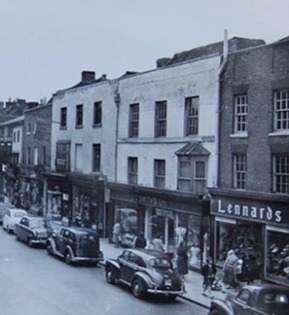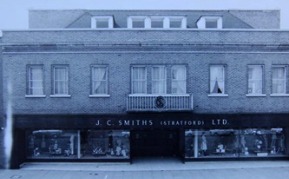Before Debenhams: 32-35 High Street
Many people will have enjoyed shopping or even working in Debenhams before it closed. The Debenhams building, however, is soon to be demolished (2025). It’s worth remembering, though, that before Debenhams, other buildings stood in that space, and the StratFire Project has been exploring these buildings, as part of its research into the fires of 1594, 1595 and 1614.
No. 32 High Street stood at what is now the entrance to Bell Court. It had a brick façade and was demolished in 1964, to be replaced by a similar building which evolved into how the space looks today. But in 1925, it was described by HE Forrest (The Old Houses of Stratford-upon-Avon) as timber-framed, ‘hidden behind a mask of brick walling’ (which had been added in 1816-17). According to Forrest, No. 32 dated from the time of Henry VIII (1509-1547). We don’t know whether the house had been affected by the fires of 1594-95, but a lease granted to a Mrs Katherine Hill in December 1595 included the requirement to undertake substantial building work, so it’s possible. Katherine, however, died in 1597, and in 1599 the house was still in a poor state.
Nos 33-34 High Street (to the north of 32) and 35 High Street (further north still), were demolished in the late 1950s to provide a space for JC Smiths Ltd (later Debenhams), which had been operating in the area since WW2. At the time of the demolition these properties were three-storey buildings with brick (stucco) fronts but timber frames had survived behind them.
At Nos 33-34, according to Forrest, there were ‘two fine panelled rooms on the first floor, nearly all Elizabethan’ (1558-1603) but the panels had been replaced by early eighteenth-century ones. It’s not known for sure if the house was affected by the fires but the occupant, an ironmonger called John Smith was, in 1595 and 1596, a sub-tenant of Adrian Quiney at No. 36 High Street (now ECCO® shoes). Perhaps this was because 33-34 was being repaired? Adrian Quiney was Thomas Quiney’s grandfather. Thomas married Judith Shakespeare in 1616.
Sadly, the original half-timbered front of Nos 33-34 High Street was removed, probably at the end of the eighteenth century, and the building wasn’t included in the official post-war listing of buildings of merit in 1951. And later that decade, as we’ve seen, the house was demolished.
Also demolished was No. 35 High Street. No early deeds survive for this property so it’s not until 1618 that we can trace ownership – to a Henry Smith. However, there is more to learn. A letter of 1931 refers to building work at the property some two decades earlier and to two Elizabethan fireplaces and a plaster overmantel. The larger fireplace has various carvings (repeated in plaster on the overmantel) including initials and wine barrels at each end. These are likely to relate to John Smith the vintner, his wife Margaret, and eldest son Ralph, baptised in 1577. There are similarities between John Smith’s overmantel and others dating from just after the 1594/1595 fires including in Harvard House and at Nos 5-6 Wood Street (now Pragnell’s). This suggests that Smith’s overmantel is of a similar age and possibly that his house also was affected by the fires.
John supplied wine to the Corporation and in his will he gave the use of most of No. 35 to his son Ralph on condition that he treated his mother well. But by 1618, and while Ralph was still alive, the freehold of the house had passed to Margaret’s brother-in-law. Some evidence also suggests that Ralph had a wayward disposition. In 1613 his name appears in a libel suit, with John Lane alleging that Mistress Hall (Shakespeare’s daughter) ‘had been naught[y] with Rafe Smith’. This may have been slander as Lane didn’t appear to defend his statement, but in 1618 Rafe was named as one of forty rioters in Stratford’s churchyard, attempting to put up the maypole, which the Corporation had just taken down. He was also fined in 1621 for not taking communion at Easter.
By 1688-89, No. 35 had become the Red Lyon, and in 1758-59 the building was also recorded as an inn although by then it was the Kings Arms.
Although refronted in the early 19th century, Forrest (1928) notes that the building retained much of its original timber framing and also mentions a tall panel in the south wall, which was glazed inside, to show the wattle-work. Sadly, however, the building is now gone.
The two fireplaces and the overmantel at No. 35 were saved, probably around 1910-11. One fireplace and the overmantel were later sold to the Ash family of Packwood House and built into the Great Hall at Packwood where they can still be seen. In 1931 the second fireplace was sold for £30 to the Shakespeare Birthplace Trust and installed in Nash’s house.
Like Nos 32-35 High Street, Debenhams will soon be demolished. Perhaps, in time, someone will be sharing Debenhams’ story?
Ellie Stevenson, 2024.
Images courtesy of the Shakespeare Birthplace Trust.
Image 1: Nos 33-34 (left) and 35 High St. (right), c1950
Image 2: JC Smith’s (later Debenham’s) as rebuilt in 1960












